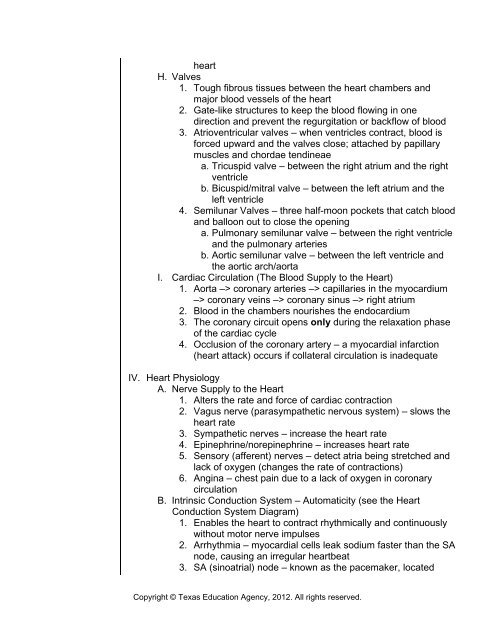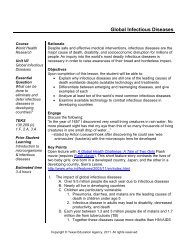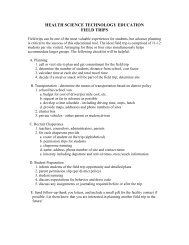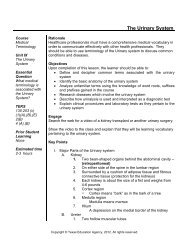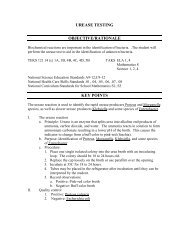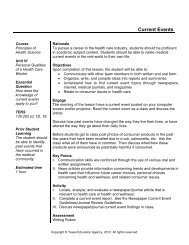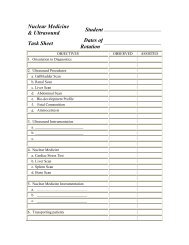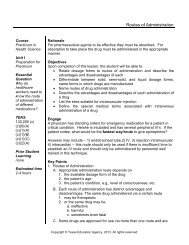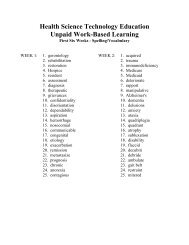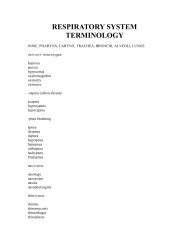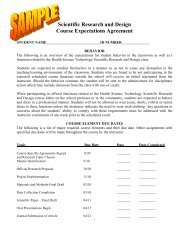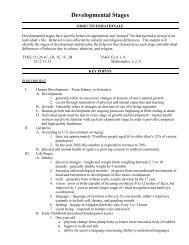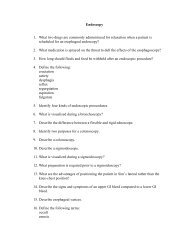Cardiovascular System - Health Science Technology Education
Cardiovascular System - Health Science Technology Education
Cardiovascular System - Health Science Technology Education
Create successful ePaper yourself
Turn your PDF publications into a flip-book with our unique Google optimized e-Paper software.
heartH. Valves1. Tough fibrous tissues between the heart chambers andmajor blood vessels of the heart2. Gate-like structures to keep the blood flowing in onedirection and prevent the regurgitation or backflow of blood3. Atrioventricular valves – when ventricles contract, blood isforced upward and the valves close; attached by papillarymuscles and chordae tendineaea. Tricuspid valve – between the right atrium and the rightventricleb. Bicuspid/mitral valve – between the left atrium and theleft ventricle4. Semilunar Valves – three half-moon pockets that catch bloodand balloon out to close the openinga. Pulmonary semilunar valve – between the right ventricleand the pulmonary arteriesb. Aortic semilunar valve – between the left ventricle andthe aortic arch/aortaI. Cardiac Circulation (The Blood Supply to the Heart)1. Aorta –> coronary arteries –> capillaries in the myocardium–> coronary veins –> coronary sinus –> right atrium2. Blood in the chambers nourishes the endocardium3. The coronary circuit opens only during the relaxation phaseof the cardiac cycle4. Occlusion of the coronary artery – a myocardial infarction(heart attack) occurs if collateral circulation is inadequateIV. Heart PhysiologyA. Nerve Supply to the Heart1. Alters the rate and force of cardiac contraction2. Vagus nerve (parasympathetic nervous system) – slows theheart rate3. Sympathetic nerves – increase the heart rate4. Epinephrine/norepinephrine – increases heart rate5. Sensory (afferent) nerves – detect atria being stretched andlack of oxygen (changes the rate of contractions)6. Angina – chest pain due to a lack of oxygen in coronarycirculationB. Intrinsic Conduction <strong>System</strong> – Automaticity (see the HeartConduction <strong>System</strong> Diagram)1. Enables the heart to contract rhythmically and continuouslywithout motor nerve impulses2. Arrhythmia – myocardial cells leak sodium faster than the SAnode, causing an irregular heartbeat3. SA (sinoatrial) node – known as the pacemaker, locatedCopyright © Texas <strong>Education</strong> Agency, 2012. All rights reserved.


